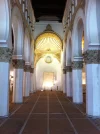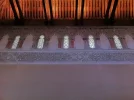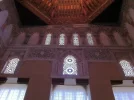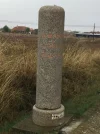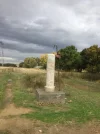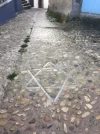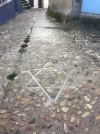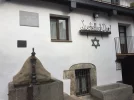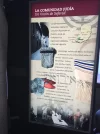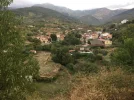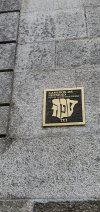I am a university student and I’m conducting research to write a final paper for my class about Jewish influence on the Camino de Santiago. I would love to interview any Sephardic Jews with stories about the Camino or anecdotes if you have seen evidence of Judaic influence/presence on the Camino! If anyone has researched this topic, please comment! There are few sources for me to examine, and I would appreciate the help!
-
Remove ads on the forum by becoming a donating member. More here.
Search 74,075 Camino Questions
You are using an out of date browser. It may not display this or other websites correctly.
You should upgrade or use an alternative browser.
You should upgrade or use an alternative browser.
What historical evidence exists of Jewish influences on the Camino de Santiago?
...and ship it to Santiago for storage. You pick it up once in Santiago. Service offered by Casa Ivar (we use DHL for transportation).
SYates
Camino Fossil AD 1999, now living in Santiago de C
- Time of past OR future Camino
- First: Camino Francés 1999
...
Last: Santiago - Muxia 2019
Now: http://egeria.house/
Hi and welcome to the forum @Farish
Are you researching Jewish settlements on/alongside the Camino, interaction (and sadly often conflicts between Jews and Christians) or Jewish influence on the pilgrimage itself?
The biggest influence was certainly that Saint James himself was born a Jew, as was that carpenter he followed ;-)
Buen Camino, SY
Are you researching Jewish settlements on/alongside the Camino, interaction (and sadly often conflicts between Jews and Christians) or Jewish influence on the pilgrimage itself?
The biggest influence was certainly that Saint James himself was born a Jew, as was that carpenter he followed ;-)
Buen Camino, SY
Thank you for such a prompt reply! I’m looking at Jewish influence on the pilgrimage itself, but that would certainly encompass the developments of the communities that dot the route and interactions/conflicts between Christians and Jews!
Ideal sleeping bag liner whether we want to add a thermal plus to our bag, or if we want to use it alone to sleep in shelters or hostels. Thanks to its mummy shape, it adapts perfectly to our body.
€46,-
€46,-
MinaKamina
Eclipsigrina ~ August 12, 2026
- Time of past OR future Camino
- Jacobspad 2017
If you speak and read Spanish, you will find many eminent publications on this subject. Google will surely help you.
Good luck with summing up over 1500 years of history in one paper.!
Good luck with summing up over 1500 years of history in one paper.!
Felipe
Veteran Member
You probably will find interesting the complicated and ambiguous history of the current Castrillo Mota de Judíos. It is close to the Camino, and in the way of cyclists that try to avoid the tough Mostelares heights.
There were Jews neigborhoods ("aljamas") in many villages and cities, notably Estella.
See http://www.redjuderias.org/google/google_maps_print/estella-es.html ;
and Raíces, revista judía de cultura. https://dialnet.unirioja.es/ejemplar/219692
(in Spanish, apparently, not online).
Also, Ponferrada
http://www.bierzotv.com/el-camino-d...-de-los-judios-en-el-bierzo-durante-400-anos/
If you have problem with Spanish, look at "Jews and Christians in Medieval Castile", from Maya Soifer Irish. There is a chapter about Camino. Some sections are in Google Books; with useful bibliography.
There were Jews neigborhoods ("aljamas") in many villages and cities, notably Estella.
See http://www.redjuderias.org/google/google_maps_print/estella-es.html ;
and Raíces, revista judía de cultura. https://dialnet.unirioja.es/ejemplar/219692
(in Spanish, apparently, not online).
Also, Ponferrada
http://www.bierzotv.com/el-camino-d...-de-los-judios-en-el-bierzo-durante-400-anos/
If you have problem with Spanish, look at "Jews and Christians in Medieval Castile", from Maya Soifer Irish. There is a chapter about Camino. Some sections are in Google Books; with useful bibliography.
- Time of past OR future Camino
- 2012, 2013, 2014.
I am a university student and I’m conducting research to write a final paper for my class about Jewish influence on the Camino de Santiago. I would love to interview any Sephardic Jews with stories about the Camino or anecdotes if you have seen evidence of Judaic influence/presence on the Camino! If anyone has researched this topic, please comment! There are few sources for me to examine, and I would appreciate the help!
Welcome Farish, I would also suggest that you contact @scruffy1 as I am sure he would be able to give you much information on the subject.
A selection of Camino Jewellery
D
Deleted member 3000
Guest
Logrono around a bar on the Camino:

Smallest_Sparrow
Life is rarely what you expect or believe it to be
- Time of past OR future Camino
- 2012: most of some, all of a few, a bit of others
A
Anemone del Camino
Guest
Minakamina,
Ouch, what a way to blow a Masters thesis up. Good thing it is not supposed orignal work for a Ph. d.
Ouch, what a way to blow a Masters thesis up. Good thing it is not supposed orignal work for a Ph. d.
Ideal sleeping bag liner whether we want to add a thermal plus to our bag, or if we want to use it alone to sleep in shelters or hostels. Thanks to its mummy shape, it adapts perfectly to our body.
€46,-
€46,-
A
Anemone del Camino
Guest
Really? The OP wants to interview people. Specifically Sepharadic jews who have walked the Camino. I would be tempted to think that his paper/web reseach is already done. Unless you are a Sephardic Jew who has walked the Camino or can refer the OP to one, how are you contributing to the OP?
- Time of past OR future Camino
- Francés x 5, Le Puy x 2, Arles, Tours, Norte, Madrid, Via de la Plata, Portuguese, Primitivo
@Anemone del Camino to whom are you replying? It looks as if you are answering the post before, which was from the original poster.
I pause before hitting the "post" button. Especially when I could be upsetting a new member who may be feeling a bit unsure.
With everyone, old and new members, I also try to remember my Camino lessons, especially that of tolerance and kindness, while on the forum. I often don't succeed, but I try.
I pause before hitting the "post" button. Especially when I could be upsetting a new member who may be feeling a bit unsure.
With everyone, old and new members, I also try to remember my Camino lessons, especially that of tolerance and kindness, while on the forum. I often don't succeed, but I try.
Fail to prepare? reduce your risk by buying this book full of practical info.
2nd ed.
2nd ed.
A
Anemone del Camino
Guest
Kanga, if you look at the time of the OP's second post and mine, you would see they are posted a minute apart. In other words, we were typing at about the same time, the OP beating me by a few seconds.@Anemone del Camino to whom are you replying? It looks as if you are answering the post before, which was from the original poster.
I pause before hitting the "post" button. Especially when I could be upsetting a new member who may be feeling a bit unsure.
With everyone, old and new members, I also try to remember my Camino lessons, especially that of tolerance and kindness, while on the forum. I often don't succeed, but I try.
I am responding to those telling the OP what to read instead of answering the question.
So no, no need to pause not to offend the OP, quite the contrary, trying to help the OP get answers asked for and not things he or she may already know. Thank you.
KinkyOne
Veteran Member
- Time of past OR future Camino
- I'am not perfect, but I'm always myself!!!
Hi, Farish,I am a university student and I’m conducting research to write a final paper for my class about Jewish influence on the Camino de Santiago. I would love to interview any Sephardic Jews with stories about the Camino or anecdotes if you have seen evidence of Judaic influence/presence on the Camino! If anyone has researched this topic, please comment! There are few sources for me to examine, and I would appreciate the help!
You actually asked "only" about Camino (de Santiago, presumably) but there are a lot of Caminos de Santiago in Spain, Portugal, France and throughout Europe:
http://www.rayyrosa.com/loscaminos
Which one are you interested in?
Are you interested in personal experiences of nowadays Camino pilgrims that are Jewish?
Are you aksing for info on Juderias (remains) and rest of the judaic influence?
Regarding that influence - architecture (the easiest), literature, gastronomy, music/dances etc?
I think you should be a bit more specific and here you can find a wealth of information from certain forum members. Photos included (as in one of the previous posts).
Good luck with your final paper and us
Ultreia!
Smallest_Sparrow
Life is rarely what you expect or believe it to be
- Time of past OR future Camino
- 2012: most of some, all of a few, a bit of others
Further apology: I am neither Jewish nor Spanish, and as someone pointed out, I can't point you to anyone to interview. But I think you were also asking about where to look for more information. I think there is a rich history throughout Spain, and from my limited travels there, especially in Toledo. I think first person interviews of Jews who have walked the Camino, their reasons, and their impressions, would be interesting. I also think there are current events, such as the recent offer of right of return citizenship, and the pros and cons discussed by those eligible, as well as genetic studies of Sephardic Jews and Spaniards, that are equally interesting. since I am a big fan of history, religion, and architecture, the intertwined aspect of those in Toledo fascinates me. It may be difficult to find historical or current contributions to the Camino but surely they existed--if in no other way, the contributions made to literature, science, and philosophy at that time. And for those who believe in love, there is the (unproved) story of Alfonso VIII and Rachel of Toledo, though like all great love stories, it has a tragic end.
The one from Galicia (the round) and the one from Castilla & Leon. Individually numbered and made by the same people that make the ones you see on your walk.
SYates
Camino Fossil AD 1999, now living in Santiago de C
- Time of past OR future Camino
- First: Camino Francés 1999
...
Last: Santiago - Muxia 2019
Now: http://egeria.house/
I repost @wayfarer 's suggestion here as it is brilliant and might get lost otherweise! To the OP, to contact a forum member directly just click on the linked name (blue) and send them a PM. Buen Camino, SY
PS @scruffy1 is from Jerusalem and has walked the Camino ...
Welcome Farish, I would also suggest that you contact @scruffy1 as I am sure he would be able to give you much information on the subject.
PS @scruffy1 is from Jerusalem and has walked the Camino ...
- Time of past OR future Camino
- cycled from Pamplona Sep 2015;Frances, walked from St Jean May/June 2017. Plans to walk Porto 2020
AS usual a great range of opinions, some excellent source suggestions and even a small lesson on posting procedures. When I first read the original OP I was almost going to suggest (tongue in cheek) that after Ferdinand II of Aragon & Isabella I of Castille there were virtually no Jews in Spain. They either converted to Christianity or left the country. However after a re-read of the OP its clear he/she is focusing on "influence" on the Camino which is definitely a really interesting topic. Might end up with a Masters Topic. Buen Camino!!
Pingüigrino
Active Member
- Time of past OR future Camino
- Frances, Aragones, Vasco del Interior, Baztanes. (Frances Winter, La Plata, Camino de Invierno, Mozarabe, Norte, Primitivo.)
Hi.
Like Saint Mike II said, from the beginining of XVI century there are not recognised Jews at Spain. And before those years the jews were not well seen by christians. They lived at Juderias, like Ghetos neighborhoods, ( when entering in Belorado, you walk in one of these Juderias) being from time to time accused of doing all kind of iniquities. IMHO, Jews had no reasons for interact with pilgrims, quite the oposite, to avoid been accused of abusing them. Those where bad times for jews all along West Europe, ( and many places of East Europe too, i´m afraid) Like Felipe suggest, Castrillo Mota de Judios, has a ambiguous history. The name of this town was Castrillo Matajudios ( Small-castel Killer of Jews , more of less) till the 25th october 2015. ( Yes, last year)
It could be interesting too considering that the open pilgrimage for all kind of persons is a modern "invention", lets say of the late 25-30 years, when this trip witch had been a catholic peregrination the late 400 years from the moment of birth of Protestantism, became a kind of tourist atraction. ( King Henry VIII of England baned the peregrination to Santiago. This ban were lifted during XX century) Luther and Calvino baned the pilgrimages too... I dont know what Jewish Doctors of Law thougth about that, but I think the jews were not encouraged to visit Santiago, and of course they would not be welcomed by the Spanish authorities, nor the Catholic Church nor the common people. When I was young, lets say 50 years ago, many people distrusted jews, and some old people used this word like a insult.
Fortunately those times finished years ago, but all those reasons are what make me think it would be difficult fo find a link between the Camino de Santiago and Jews.
Buen Camino to you , all honest people.
http://www.diariodeburgos.es/notici...di/abarcara/5/siglos/influencia/judia/comarca
Like Saint Mike II said, from the beginining of XVI century there are not recognised Jews at Spain. And before those years the jews were not well seen by christians. They lived at Juderias, like Ghetos neighborhoods, ( when entering in Belorado, you walk in one of these Juderias) being from time to time accused of doing all kind of iniquities. IMHO, Jews had no reasons for interact with pilgrims, quite the oposite, to avoid been accused of abusing them. Those where bad times for jews all along West Europe, ( and many places of East Europe too, i´m afraid) Like Felipe suggest, Castrillo Mota de Judios, has a ambiguous history. The name of this town was Castrillo Matajudios ( Small-castel Killer of Jews , more of less) till the 25th october 2015. ( Yes, last year)
It could be interesting too considering that the open pilgrimage for all kind of persons is a modern "invention", lets say of the late 25-30 years, when this trip witch had been a catholic peregrination the late 400 years from the moment of birth of Protestantism, became a kind of tourist atraction. ( King Henry VIII of England baned the peregrination to Santiago. This ban were lifted during XX century) Luther and Calvino baned the pilgrimages too... I dont know what Jewish Doctors of Law thougth about that, but I think the jews were not encouraged to visit Santiago, and of course they would not be welcomed by the Spanish authorities, nor the Catholic Church nor the common people. When I was young, lets say 50 years ago, many people distrusted jews, and some old people used this word like a insult.
Fortunately those times finished years ago, but all those reasons are what make me think it would be difficult fo find a link between the Camino de Santiago and Jews.
Buen Camino to you , all honest people.
http://www.diariodeburgos.es/notici...di/abarcara/5/siglos/influencia/judia/comarca
Last edited:
Get a spanish phone number with Airalo. eSim, so no physical SIM card. Easy to use app to add more funds if needed.
Rainerbernd
Active Member
- Time of past OR future Camino
- On St James ways since 1971
I am a university student and I’m conducting research to write a final paper for my class about Jewish influence on the Camino de Santiago. I would love to interview any Sephardic Jews with stories about the Camino or anecdotes if you have seen evidence of Judaic influence/presence on the Camino! If anyone has researched this topic, please comment! There are few sources for me to examine, and I would appreciate the help!
Olá Farish, for your research you should contact Christoph Kühn at Biblioteca Jacobina in Cologne. This special library has tons of information.
Link http://www.pilgerbibliothek.de/:
SYates
Camino Fossil AD 1999, now living in Santiago de C
- Time of past OR future Camino
- First: Camino Francés 1999
...
Last: Santiago - Muxia 2019
Now: http://egeria.house/
Major DOOH! moment (also called a senior moment) just remembered this well known verse from the poem "La Preciosa" from the ~13th Century, Roncesvalles, and printed on a lot of nowadays credenciales:
“La puerta se abre a todos, enfermos y sanos; no sólo a los católicos sino aun a paganos, a judíos, herejes, ociosos y vanos”
As far as I know that poem referred to the general hospitality in Roncesvalles, not only the pilgrim-specific one.
Also a good contact point might be Jose Luis Barreda at http://bibliotecajacobea.org in Carrion de los Condes (Palencia).
Buen Camino, SY
“La puerta se abre a todos, enfermos y sanos; no sólo a los católicos sino aun a paganos, a judíos, herejes, ociosos y vanos”
As far as I know that poem referred to the general hospitality in Roncesvalles, not only the pilgrim-specific one.
Also a good contact point might be Jose Luis Barreda at http://bibliotecajacobea.org in Carrion de los Condes (Palencia).
Buen Camino, SY
- Time of past OR future Camino
- 2019
In Galicia the most important juderías Allariz, Ribadavia, Ourense, Monforte and A Coruña weren´t near the Camino Francés but porbably some families (doctors, shoemakers, tailors) lived near the Camino in places like Portomarín and Sarria to provide services to pilgrims
A selection of Camino Jewellery
Pingüigrino
Active Member
- Time of past OR future Camino
- Frances, Aragones, Vasco del Interior, Baztanes. (Frances Winter, La Plata, Camino de Invierno, Mozarabe, Norte, Primitivo.)
Major DOOH! moment (also called a senior moment) just remembered this well known verse from the poem "La Preciosa" from the ~13th Century, Roncesvalles, and printed on a lot of nowadays credenciales:
“La puerta se abre a todos, enfermos y sanos; no sólo a los católicos sino aun a paganos, a judíos, herejes, ociosos y vanos”
As far as I know that poem referred to the general hospitality in Roncesvalles, not only the pilgrim-specific one.
Also a good contact point might be Jose Luis Barreda at http://bibliotecajacobea.org in Carrion de los Condes (Palencia).
Buen Camino, SY
Yes, it is true. This was what this poem said. And probably it was true, because the hospitality was a very important tradition, but please note that Roncesvalles being a very important place in the Camino de Santiago, was the VERY important place too on the border, on the Pyrenees, and probably there were some kind of hospitality on that place centuries before St. James tomb were found, during Roman empire . That was the reason of the hospitality, because any person crossing the border, probably would die if the hospitality were denied, but at other places existed laws about who can be called a pilgrim and who nor. And those who call themselves pilgrims, but where´nt according those laws, could finishing their lives rowing in a galley, diging for plumb or mercury in a deep mine or on the gallows All along Spain is easy to find trace of our jewish heritage ( probably in my family there was any of those converts jews), many juderias, synagogues, etc. But if you research the history of Spain, you will find jews were a hated people, second class vassals ( No citizens in those years) despite their prosperity (perhaps BECAUSE their prosperity)...
This is the reason IMHO because Farish cant find many resources about the influence of jewish/judaic on the Camino itself. Because probably there was not this influence, like a wrote in my previous post, jews usually lives on their own "ghettos" , the aljamas, what we know actually like Juderias.
But not being a expert historian about this thematic, would like to learn anything new about this.
Last edited:
- Time of past OR future Camino
- cycled from Pamplona Sep 2015;Frances, walked from St Jean May/June 2017. Plans to walk Porto 2020
Hola SY I think this is the correct translation?? (Or at least I hope so).
"The door is open to everyone, sick and healthy; not only Catholics but even pagans, Jews, heretics, idle and vain "
I hope that this is still the creed / philosophy of the Camino today. A true Buen Camino to all.
"The door is open to everyone, sick and healthy; not only Catholics but even pagans, Jews, heretics, idle and vain "
I hope that this is still the creed / philosophy of the Camino today. A true Buen Camino to all.
Pingüigrino
Active Member
- Time of past OR future Camino
- Frances, Aragones, Vasco del Interior, Baztanes. (Frances Winter, La Plata, Camino de Invierno, Mozarabe, Norte, Primitivo.)
Hola SY I think this is the correct translation?? (Or at least I hope so).
"The door is open to everyone, sick and healthy; not only Catholics but even pagans, Jews, heretics, idle and vain "
I hope that this is still the creed / philosophy of the Camino today. A true Buen Camino to all.
Yes it is. Nowadays every well meaning person is welcome to the Camino.
The one from Galicia (the round) and the one from Castilla & Leon. Individually numbered and made by the same people that make the ones you see on your walk.
SYates
Camino Fossil AD 1999, now living in Santiago de C
- Time of past OR future Camino
- First: Camino Francés 1999
...
Last: Santiago - Muxia 2019
Now: http://egeria.house/
Hola SY I think this is the correct translation?? (Or at least I hope so).
"The door is open to everyone, sick and healthy; not only Catholics but even pagans, Jews, heretics, idle and vain "
I hope that this is still the creed / philosophy of the Camino today. A true Buen Camino to all.
Very good translation and yes, because it is in the Camino spirit, it is still printed on many credenciales ;-) Buen Camino, SY
KinkyOne
Veteran Member
- Time of past OR future Camino
- I'am not perfect, but I'm always myself!!!
From my memory walking Frances in 2009 and 2011 there is one of the biggest juderias/aljamas on CF in Estella. Generally the part of the town to the right over the river as you enter....like a wrote in my previous post, jews usually lives on their own "ghettos" , the aljamas, what we know actually like Juderias.
- Time of past OR future Camino
- Frances (SJPdP - SdC)
Port. (Porto -SdC - Finis)
Not directly Camino related, but full of color and historic details of what happened to the Spanish Jews around 1492, is Noah Gordon's novel The Last Jew. It's a fabulous read.
https://en.wikipedia.org/wiki/The_Last_Jew?wprov=sfla1
https://en.wikipedia.org/wiki/The_Last_Jew?wprov=sfla1
3rd Edition. Vital content training & pack guides avoid common mistakes, bed bugs etc
newfydog
Veteran Member
- Time of past OR future Camino
- Pamplona-Santiago, Le Puy- Santiago, Prague- LePuy, Menton- Toulouse, Menton- Rome, Canterbury- Lausanne, Chemin Stevenson, Voie de Vezelay
Hi.
They lived at Juderias, like Ghetos neighborhoods, ( when entering in Belorado, you walk in one of these Juderias)
.
I find those old Jewish neighborhoods fascinating. I had a guidebook which mentioned several of them, but it really would be interesting to to go through some of the Camino towns with a historian, or at least a map with some details of them.
Malcolm
New Member
- Time of past OR future Camino
- 2017
Tidbit in both senses of the term.One little tidbit: the Galician Tarta de Santiago is thought to have originally been a Passover cake - it's made with almond flour and no leavening.
Ideal sleeping bag liner whether we want to add a thermal plus to our bag, or if we want to use it alone to sleep in shelters or hostels. Thanks to its mummy shape, it adapts perfectly to our body.
€46,-
€46,-
Malcolm
New Member
- Time of past OR future Camino
- 2017
There is evidence of quite a significant Jewish presence in Oviedo, which of course is the starting point of the Camino Primitivo and has also been the object of a (lengthy) detour for pilgrims on the Camino Francés. There's some information about the Jewish people of Oviedo at http://www.redjuderias.org/google/google_maps_print/oviedo-en.html.
- Time of past OR future Camino
- Francese 2002, Cami San Jaume 2018, Norte 2023
I have met a number (well, 6 or 7) Jews on the Camino, and the two sephardim were Israeli-- one of them descended from the Valencian community via Salonika, whose grandmother was preserved from the trains heading north to the death camps by the heroic Spanish consul there during the 1940s. Otherwise, they were Ashkenazi from the US and none of them knew much of Spanish Jewish history. The excellent Red de Juderias site was mentioned early on in this thread. The church of San Lorenzo in Sahagun was built (by Muslim masons) quite close to the juderia there which, if memory serves me well, was expelled in the 1430s
KinkyOne
Veteran Member
- Time of past OR future Camino
- I'am not perfect, but I'm always myself!!!
Generally Ashkenazi are (were) East European Jews and Sefards are (were) West European Jews. Ashkenazis were mostly either executed in nazi camps or transfered to nowadays Israel whereas Sefards still remains (although many of them forcefully embraced Christianism back in the history) in France and Spain. Their culture is just amazing.I have met a number (well, 6 or 7) Jews on the Camino, and the two sephardim were Israeli-- one of them descended from the Valencian community via Salonika, whose grandmother was preserved from the trains heading north to the death camps by the heroic Spanish consul there during the 1940s. Otherwise, they were Ashkenazi from the US and none of them knew much of Spanish Jewish history. The excellent Red de Juderias site was mentioned early on in this thread. The church of San Lorenzo in Sahagun was built (by Muslim masons) quite close to the juderia there which, if memory serves me well, was expelled in the 1430s
Just a bit of it here:
Ideal sleeping bag liner whether we want to add a thermal plus to our bag, or if we want to use it alone to sleep in shelters or hostels. Thanks to its mummy shape, it adapts perfectly to our body.
€46,-
€46,-
- Time of past OR future Camino
- Francese 2002, Cami San Jaume 2018, Norte 2023
Sephardim were also sent to the camps whenever the Nazis could get hold of them-- they were scattered about the Mediterranean, and Italian, Adriatic-region, and French Sephardim suffered terribly. Spanish diplomats, most notably in Greece, Bulgaria, and Hungary, exercised their authority under traditional Spanish citizenship laws which accorded citizenship to anyone descended from a Spanish subject and provided them with protection. Sephardim can be found in all sorts of places, with a synagogue and school about 3km walk from me in Ottawa-- Haketia, an Iberian/Moroccan version of Ladino, is still spoken by a few older residents.
lunna
Active Member
- Time of past OR future Camino
- frances; lisboa-muxia; norte+bayonne; vdlp; le puy; voie d'arles+aragones; geneva to ales
Hervas on the Via de la Plata has a well-preserved Juderia, although no Jews (except for one Israeli woman who moved there a few years back) actually live there ...
Last edited:
JabbaPapa
"True Pilgrim"
- Time of past OR future Camino
- 100 characters or fewer : see signature details
This is an undergraduate paper, and while yes, I have been searching Google and my university’s library for a month or two so far, it is difficult to find material on this particular topic for some reason.
Likely because the degree of influence is minor --- the only link I can think of is in the so-called Grand Tour that some wealthy European youths engaged in between the end of the Middle Ages and the 19th centuries. It was structured around pilgrimages to Rome and Jerusalem, by varied means of transport, and the Camino was likely included by some as a variant.
Because of the presence of the Templars, likely not even the banking services traditionally provided by the Jews were in much demand on the Camino.
I concur with the suggestions of many that whatever influence will most likely be found in places along the Camino than in the Camino itself.
A selection of Camino Jewellery
JabbaPapa
"True Pilgrim"
- Time of past OR future Camino
- 100 characters or fewer : see signature details
Major DOOH! moment (also called a senior moment) just remembered this well known verse from the poem "La Preciosa" from the ~13th Century, Roncesvalles, and printed on a lot of nowadays credenciales:
“La puerta se abre a todos, enfermos y sanos; no sólo a los católicos sino aun a paganos, a judíos, herejes, ociosos y vanos”
As far as I know that poem referred to the general hospitality in Roncesvalles, not only the pilgrim-specific one.
It's a shorter and simplified version of the welcome sign at the pilgrim hostel at Roncesvalles -- BTW "pagan" in the Middle Ages referred usually to Muslims. The word "ociosos" basically means "tramps".
It's a good illustration of the fact that mediaeval European Catholics were nothing like the caricature that is made of them, but they were as friendly, tolerant, welcoming as we are ourselves on our better days.
nellpilgrim
Veteran Member
- Time of past OR future Camino
- SDC-Fisterra 08/Camino Frances SJPP to SDC 09/Nuremburg-SDC 11- ongoing
Claudia Roden the food writer was the first to point out that Tarta De Santiago was, in essence, a Jewish Passover cake (see' The food of Spain' Claudia Roden page 472 for a cracking recipe!)
Roden also pointed out that in addition to existing Jewish communities in the area Jews from Andalucia who were fleeing the BerberAlmohads attempts to convert them went to Galicia in the 12th and 13th centuries.
Roden also pointed out that in addition to existing Jewish communities in the area Jews from Andalucia who were fleeing the BerberAlmohads attempts to convert them went to Galicia in the 12th and 13th centuries.
Ideal sleeping bag liner whether we want to add a thermal plus to our bag, or if we want to use it alone to sleep in shelters or hostels. Thanks to its mummy shape, it adapts perfectly to our body.
€46,-
€46,-
lunna
Active Member
- Time of past OR future Camino
- frances; lisboa-muxia; norte+bayonne; vdlp; le puy; voie d'arles+aragones; geneva to ales
If you look closely, the second line is in Hebrew (the word "derech" - which is in script - means 'via' or 'way' in Hebrew - the rest loops around the side - there are many, many of these markers along the Via de la Plata in Castilla y Leon). The third line is in Arabic.
The 2024 Camino guides will be coming out little by little. Here is a collection of the ones that are out so far.
D
Deleted member 3000
Guest
€2,-/day will present your project to thousands of visitors each day. All interested in the Camino de Santiago.
- Time of past OR future Camino
- SJPdP > Santiago - 2016
Porto > Santiago - 2018
If no one else suggested it Pilgrimage and the Jews by David M. Gitlitz and Linda Kay Davidson may be a good resource for you. Buen Camino.
- Time of past OR future Camino
- SJPdP > Santiago - 2016
Porto > Santiago - 2018
Are you familiar with the contents of this book? Amazon allows a search of the book and when I entered camino or Santiago or Compostela it came up with zero results. Judging by the table of contents, it seems to be a book about Jewish pilgrimages with destinations that are, obviously, to sites outside of Spain?
What you say is true, but David and Linda did meet on the Camino, and fell in love with each other as well as the pilgrimage stories of the Jews. I suggested it (no help to the OP, who I see asked in 2016) for anyone interested in the seeming mysterious answer to the question regarding Jews on pilgrimage in general. They were doing it before there were Christians so it makes sense to understand that story to get the whole picture.
The one from Galicia (the round) and the one from Castilla & Leon. Individually numbered and made by the same people that make the ones you see on your walk.
- Time of past OR future Camino
- Frances, autumn/winter; 2004, 2005-2006, 2007, 2008, 2009, 2010, 2011, 2012, 2013, 2014, 2015
JodiT,I am just reading this thread now, in September of 2022. I am wondering if the OP ended up writing the thesis, and if anyone else has more information on this. I am an Ashkinazi Jew, currently on the Camino.
Welcome to the forum!
Where are you now?
After Burgos and Castrojeriz on the Camino Frances as you climb the Alto de Mostelares; you will see widely; to the east the path taken from Castrojeriz and to the west the path to take.
Looking north you might glimpse the location of Mota de los Judios, a "lost" 13th c Jewish settlement recently excavated. Archeological finds from the site were published 2018 in this
illustrated scholarly overview. The bibliigraphy will be useful for further research.
May you have apples and honey to celebrate the New Year and
wherever you do go Carpe diem!
Last edited:
Thank you! I started walking with a group from Logrono to Burgos. The group ended, and I took a bus and train to Sarria, and have been walking on my own. I will get to Santiago de Compostela tomorrow morning. It has been a nice combination: walking with a group, and then walking on my own. I have asked myself countless times “why am I doing this” and “why are all these people doing this”. I can understand that 1000 years ago, people had religious beliefs about the camino. But it seems that very few do now. Even many Catholics don’t seem to have a firm conviction of what they are doing here. Me? I really liked the idea of a spiritual journey, and being with others on a spiritual journey. For many, though, it doesn’t seem spiritual. They are constantly talking with their companions about every day things - things they would be talking about if they were sitting at home. I have enjoyed some alone time in my walking. Time to contemplate, to think about how I want to improve my life, to live it to be more true to myself.JodiT,
Welcome to the forum!
Where are you now?
After Burgos and Castrojeriz on the Camino Frances as you climb the Alto de Mostelares; you will see widely; to the east the path taken from Castrojeriz and to the west the path to take.
Looking north you might glimpse the location of Mota de los Judios, a "lost" 13th c Jewish settlement recently excavated. Archeological finds from the site were published 2018 in this
illustrated scholarly overview. The bibliigraphy will be useful for further research.
May you have apples and honey to celebrate the New Year and
wherever you do go Carpe diem!
€2,-/day will present your project to thousands of visitors each day. All interested in the Camino de Santiago.
- Time of past OR future Camino
- Frances - Oct/Dec 21
VdlP - Apr/Jun 23
Not sure if it will be of any use, but I came across a podcast only last week by Paul Burge (When in Spain). The podcast title is 'Sephardic Roots - Jewish History in Spain & Sephardic Ancestry Citizenship'. While not specific to the Camino it may, nevertheless, provide some further reference/contacts for your studies. I think it might be worth a look, and I certainly quite enjoyed this episode.
Good luck.
Good luck.
Ultreia et Suseia!
Camino training yields the best packing list!
- Time of past OR future Camino
- From O Porto in September.
I know it's an old thread, but I found this when walking through TuiThank you for such a prompt reply! I’m looking at Jewish influence on the pilgrimage itself, but that would certainly encompass the developments of the communities that dot the route and interactions/conflicts between Christians and Jews!
Attachments
❓How to ask a question
How to post a new question on the Camino Forum.
Most read last week in this forum
....any Camino.
Further to the thread about Monks at Roncevalles, how many Monks actually live along the Camino Frances.
I recall seeing quite a few Nuns, but very few Monks, I think one signed...
I made an interesting discovery this morning which I wish to share.
For most of my long life I've been an admirer of that early 20thC English 'Poet and Man of Letters' Hilaire Belloc....This...
Good Day!
I guess this falls under Culture.
There's usually a classical Spanish guitar festival in Carrion during the Summer ... I had the luck to attend one of the concerts this summer (2024) and...
I know the Mozarabic Rite masses can be attended in Toledo but what about anywhere else along the Caminos ?
Similar threads
- Replies
- 62
- Views
- 4K
- Replies
- 27
- Views
- 2K
- Replies
- 27
- Views
- 2K
- Replies
- 8
- Views
- 2K
❓How to ask a question
How to post a new question on the Camino Forum.
Most downloaded Resources
-
“All” Albergues on the Camino Frances in one pdf“All” Albergues on the Camino Frances in one pdf
- ivar
- Updated:
-
A selection of favorite albergues on the Camino FrancésFavorite Albergues along the Camino Frances
- Ton van Tilburg
- Updated:
-
Profile maps of all 34 stages of the Camino FrancesProfile maps of all 34 stages of the Camino Frances
- ivar
- Updated:





